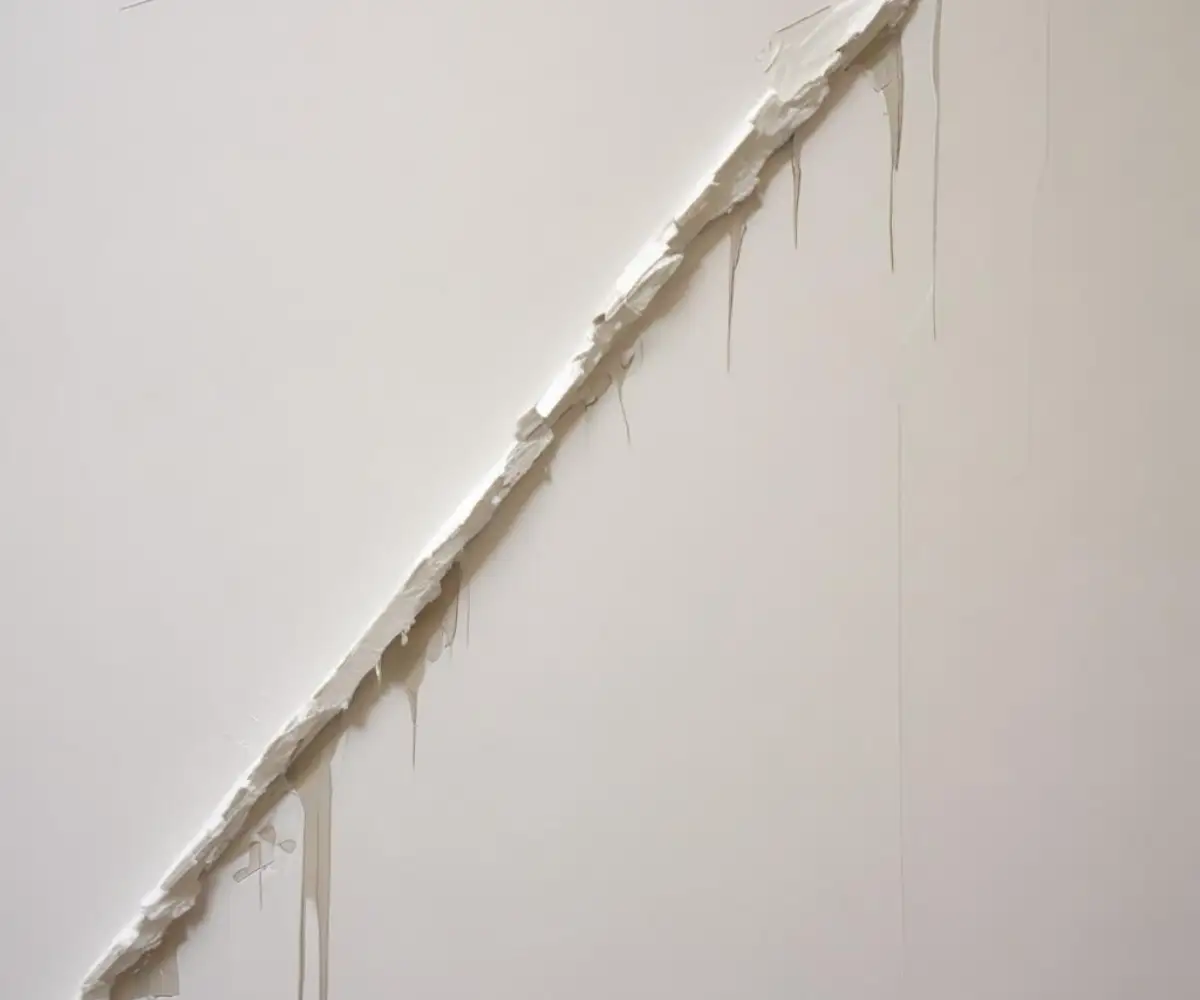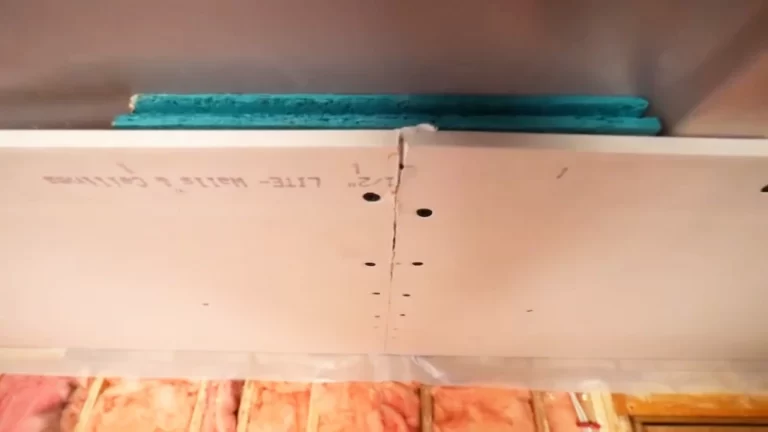Drywall Tape Showing Through Mud? Causes and Repair Guide
You’ve spent hours, maybe even days, hanging drywall, taping, and mudding. You stand back to admire your work, only to be met with a frustrating sight: the faint but unmistakable outline of drywall tape showing through the mud. It’s a common problem that plagues DIYers and even some professionals, turning a nearly perfect wall into a flawed surface that will scream “amateur” once the paint goes on.
This phenomenon, often called “ghosting” or “flashing,” can make your finished walls look uneven and unprofessional. But don’t despair. Understanding why it happens is the first step to fixing it for good and ensuring your future drywall projects are flawless from the start.
You'll Learn About
Why Can You See Drywall Tape Through the Mud? Uncovering the Root Causes
Seeing the tape lines is not just one single mistake, but often a combination of factors. When the joint compound, or “mud,” isn’t applied correctly, it fails to adequately conceal the tape that bridges the gap between drywall sheets. Let’s break down the most common culprits behind this frustrating issue.
Cause #1: Not Enough Joint Compound
The most straightforward reason for visible tape is simply not applying enough mud over it. Drywall finishing is a layering process. A single coat is never enough to hide the tape, especially after sanding. Many beginners are afraid of creating a hump and apply too little mud, which results in the tape’s texture or edges showing through.
Each coat of mud serves a purpose: the first embeds the tape, the second fills and flattens the joint, and the third provides the final, wide feathering needed for a seamless finish. If you can see the tape after your second coat, it’s a sign that you need at least one more, wider coat. If you can still see it after the third, you may need to apply another thin, wide skim coat.
Cause #2: Oversanding the Joints
Sanding is where the art of drywall finishing truly comes to life, but it’s also where things can go wrong. Being too aggressive with your sanding can quickly remove the thin layers of mud covering the tape. This is an incredibly common mistake, especially for those new to the process.
Using a coarse-grit sandpaper or applying too much pressure can wear down the compound and expose the paper or mesh tape underneath. The goal of sanding is to smooth the transitions and knock down high spots, not to reshape the joint. If you find yourself creating a lot of dust, you might be sanding too much and undoing all your hard work.
Cause #3: Improper Tape Embedment
The very first coat of mud is critical because its job is to fully embed the tape, creating a solid bond with the drywall. If there isn’t enough mud behind the tape, or if air bubbles get trapped, the tape won’t lie flat. This can cause visible lines, ridges, or bubbles that subsequent coats of mud can’t hide.
Applying too much pressure with your taping knife when embedding the tape can squeeze out too much mud from behind it, starving the bond. Conversely, not applying enough pressure can leave air bubbles. It’s a delicate balance that requires practice to perfect.
Cause #4: Incorrect Mud Consistency
The consistency of your joint compound plays a huge role in how well it applies and covers. If the mud is too thick, it can be difficult to spread evenly and may tear the tape. If it’s too thin and watery, it will shrink excessively as it dries, which can cause the outline of the tape to reappear.
For taping, you want a consistency similar to creamy peanut butter. It should be smooth and hold its shape on your knife without being stiff. Achieving the right consistency, especially with powdered compounds, is key to a professional finish.
The Step-by-Step Solution: How to Fix Visible Drywall Tape
If you’re currently staring at a wall with tape lines showing, don’t worry—it’s fixable. You don’t need to tear anything out. The solution is to build up the area with more thin layers of joint compound, feathering the edges out to create a wider, flatter joint that blends seamlessly into the rest of the wall.
Step 1: Assess and Prepare the Surface
First, run your hand and a wide taping knife over the joint to feel for imperfections. Is it a ridge? A depression? Can you feel the edge of the tape? Identifying the exact problem will help you fix it effectively. Lightly sand the area with 120-grit sandpaper to remove any high spots or rough patches and wipe away all the dust with a damp cloth. A clean, smooth surface is essential for the new mud to adhere properly.
Step 2: Apply a Thin Skim Coat
Using an all-purpose joint compound, apply a thin coat directly over the visible tape line. The key here is to use a wider drywall knife than you used for your previous coats. If you used a 6-inch knife before, step up to a 10-inch or 12-inch knife. This wider knife will allow you to feather the edges of the new mud much farther out from the center of the joint.
Hold the knife at a low angle to the wall to apply the mud, and then increase the angle to smooth it out and remove any excess. You are not trying to build a thick layer; you are trying to create a very gradual slope away from the seam.

Step 3: Feather the Edges
The secret to invisible drywall joints is feathering. This means applying pressure to the outer edge of your knife, so the mud becomes progressively thinner as it spreads away from the joint. The center of the joint will have a slightly thicker layer of mud, while the outer edges will be virtually non-existent, blending perfectly with the drywall surface.
This technique is crucial for hiding repairs and ensuring the joint doesn’t create a visible hump on the wall. After applying the skim coat, let it dry completely—usually for 24 hours.
Step 4: Light Sanding and Re-coating if Necessary
Once the compound is fully dry, lightly sand it with a fine-grit sanding sponge or 150-grit sandpaper. Your goal is just to smooth it out, not remove the layer you just applied. After sanding, wipe away the dust and inspect your work. Shine a light across the surface at a low angle to reveal any remaining imperfections.
If you can still see or feel the tape line, you may need to repeat the process with another thin skim coat, extending it even wider than the last. Patience is key; it’s better to apply multiple thin coats than one thick one.
Step 5: Prime Before You Paint
Once you are satisfied with the smoothness of the joint, you must prime the patched area before painting. Joint compound absorbs paint differently than the paper on the drywall surface. Priming ensures that the final paint coat will have a uniform sheen and color, preventing the repair from flashing through the paint.
Prevention is the Best Medicine: Taping Tips for a Flawless Finish
Fixing mistakes is one thing, but avoiding them in the first place saves a lot of time and frustration. For your next project, keep these pro tips in mind to ensure your drywall tape stays hidden for good.
Use the Right Tools for the Job
Having a good set of drywall knives is non-negotiable. You’ll need at least a 6-inch knife for embedding tape and 10-inch and 12-inch knives for your fill and finish coats. Wider knives are essential for feathering the mud properly over the joints.
Even complex jobs like finishing around obstacles can be made easier with the right approach. If you ever need to work around something tricky, like a pipe, knowing how to approach a drywall over protruding pipe installation can save you a major headache.
The Three-Coat Standard
Don’t try to finish a joint in one or two coats. Adhering to the three-coat system is the professional standard for a reason. Each coat builds on the last to create a strong, flat, and invisible seam.
- First Coat (Tape Coat): Apply a generous bed of mud and embed the tape firmly, squeezing out a small amount of excess mud from underneath.
- Second Coat (Fill Coat): Apply a wider coat that completely covers the tape and begins to flatten the joint.
- Third Coat (Finish Coat): Use your widest knife to apply a final, thin coat feathered out at least 10-12 inches wide.
This systematic approach ensures complete coverage and a gradual transition. This is especially important for projects in challenging spaces, like when you have to figure out how to get drywall into basement areas where maneuverability is limited.
Choose the Right Tape and Mud
While mesh tape can be easier for beginners because it’s self-adhesive, paper tape generally produces a stronger, flatter joint when embedded properly. For mud, an all-purpose compound works well for all three coats. Some pros prefer a lighter-weight topping compound for the final coat as it’s easier to sand.
The environment also plays a role. For instance, understanding the nuances of insulation between brick and drywall can impact wall stability and moisture levels, which indirectly affect the longevity of your drywall finish.
Mastering Mud Consistency
Take the time to mix your mud to the right consistency. Pre-mixed mud often needs a little water added to make it perfect for taping. It should glide on smoothly without being runny. A poor mix will fight you every step of the way.
Here is a quick reference guide to help you diagnose and solve common taping issues.
| Symptom | Common Cause | Solution |
|---|---|---|
| Tape outline is visible | Not enough mud applied over the tape; over-sanding. | Apply another thin skim coat with a wider knife, feathering the edges. |
| Bubbles under the tape | Not enough mud behind the tape; compound dried too quickly. | Cut the bubble out with a utility knife, re-apply mud, and patch with new tape. |
| Visible ridge or hump at joint | Too much mud built up; not feathering edges wide enough. | Sand down the high spot and apply a very wide skim coat to blend the hump into the wall. |
| Cracks along the tape edge | Tape was not properly embedded; too little mud. | Remove loose tape, re-tape the joint with a proper bed of mud. |
Achieving the Perfect Finish
Seeing drywall tape through the mud is a dispiriting setback, but it’s a common part of the learning curve. By understanding the core causes—insufficient mud, over-sanding, and improper embedding—you can not only fix existing issues but also prevent them from happening again.
Remember that drywall finishing is a craft that rewards patience and technique. Use the right tools, apply thin, wide coats, and always, always prime before you paint. With these principles in mind, you can achieve the smooth, seamless walls that are the hallmark of a professional job.

